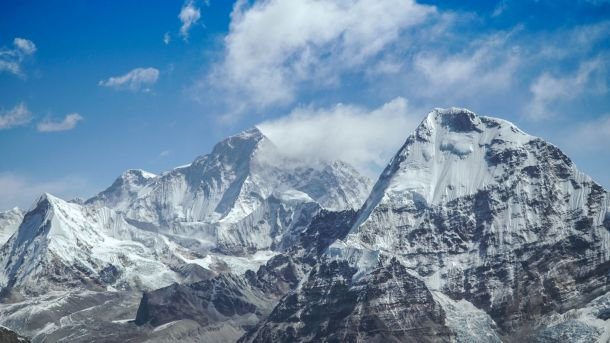Top 30 Unknown and Interesting Facts About The Himalayas
A beautiful mountain range in Asia, the Himalayas—also known as the Himalaya Mountain Range—serve as a natural border between the Tibetan Plateau and the Indian subcontinent. With more than 100 summits rising beyond 7,200 meters (23,600 feet) in elevation, the Himalayas are home to some of the highest peaks on Earth, including the well-known Mount Everest.
The Indian and Eurasian tectonic plates colliding more than 50 million years ago created the Himalayas. In addition to producing tall peaks, this geological event had an impact on the local ecosystems and climate. A variety of temperatures and ecosystems can be found on either side of the range since it serves as a barrier against the chilly winds coming from the north. The northern side gives way to Tibet’s barren terrain, while the southern slopes see abundant rainfall and are covered in lush woods.
The diversity of plants and animals found in the Himalayas is astounding. From tropical to alpine, the various climate zones sustain ecosystems that include high-altitude grasslands and dense pine and rhododendron forests. Here, rare animals like the Himalayan tahr, red panda, and snow leopard flourish. Since the Himalayas are the source of important rivers like the Ganges, Indus, and Brahmaputra, the area is also vital to the world’s water supply.
The Himalayas have deep cultural and spiritual significance in addition to their natural splendor. In Buddhism, Jainism, and Hinduism, they are revered. Millions of devotees visit several pilgrimage sites annually, including the Char Dham in India and Lumbini in Nepal, the birthplace of Buddha. A rich tapestry of customs, dialects, and practices is created by the numerous populations that call the foothills home, such as the Sherpas, Bhutias, and various Tibetan tribes.

Travelers and explorers from all over the world are drawn to the Himalayas by their attraction. Trekking routes that offer stunning vistas and the opportunity to explore the region’s distinct culture include the Annapurna Circuit and the Everest Base Camp climb. But there are drawbacks to this surge of tourists as well, such environmental damage and cultural upheaval, which raise questions about conservation and sustainable practices.
Here are 30 fascinating and lesser-known facts about this iconic region.
1. The Name “Himalaya”
The name “Himalaya” comes from the Sanskrit words “hima” meaning snow and “alaya” meaning abode, thus translating to “abode of snow.” This name aptly reflects the perpetual snow that crowns these towering peaks.
2. Youngest Mountain Range
The Himalayas are considered the youngest mountain range in the world, formed around 50 million years ago due to the collision of the Indian tectonic plate with the Eurasian plate. This geological activity is still ongoing, causing the mountains to rise a few millimeters each year.
3. Home to the World’s Highest Peak
Mount Everest, standing at 8,848 meters (29,029 feet) above sea level, is the highest peak in the world. It attracts climbers from all over the globe, ranging from experienced mountaineers to novice adventurers.
4. Biodiversity Hotspot
The Himalayas are a biodiversity hotspot, home to more than 10,000 species of flowering plants, over 300 species of mammals, and 600 species of birds. Some of the notable animals include the snow leopard, red panda, and the Himalayan tahr.
5. The Indus, Ganges, and Brahmaputra
The major rivers of the Indian subcontinent—the Indus, Ganges, and Brahmaputra—originate in the Himalayas. These rivers are crucial for the agriculture, culture, and economy of millions of people.
6. Diverse Climate Zones
The Himalayas exhibit a wide range of climate zones, from the tropical conditions in the foothills to the tundra and polar conditions at the highest elevations. This diversity contributes to the rich variety of flora and fauna.
7. Ancient Trade Routes
The Himalayas have been traversed for centuries by traders and pilgrims. The ancient Silk Road ran along parts of this range, facilitating trade between India and Tibet, and further to China and Central Asia.
8. Spiritual Significance
The Himalayas hold immense spiritual significance in Hinduism, Buddhism, and other religions. They are considered sacred and have numerous temples, monasteries, and pilgrimage sites, including the revered Mount Kailash.
9. Sherpa Culture
The Sherpas, an ethnic group native to the mountainous regions of Nepal, are renowned for their mountaineering skills and hospitality. Their culture is rich with traditions, and they play a vital role in assisting climbers on Everest and other peaks.
10. The Living Goddess
In Nepal, the tradition of the “Kumari” or living goddess is prevalent. This practice involves selecting a young girl from the Newar community to serve as a goddess until she reaches puberty, emphasizing the intersection of religion and culture in the Himalayas.
11. Glacial Melting
The Himalayas are home to some of the largest glaciers outside the polar regions. However, due to climate change, these glaciers are melting at an alarming rate, posing threats to water supply and ecosystem stability in the region.
12. Unique Flora
One of the most unique aspects of the Himalayas is the diversity of flora. You can find everything from rhododendron forests to alpine meadows, and the region is famous for its medicinal plants, many of which are used in traditional medicine.
13. The Great Himalayan Trail
The Great Himalayan Trail is one of the longest and highest trekking routes in the world. Stretching over 1,700 kilometers (1,056 miles), it traverses the length of the Himalayas, offering breathtaking views and cultural experiences.
14. The Yeti Myth
The legend of the Yeti, often referred to as the “Abominable Snowman,” has its roots in the Himalayas. This elusive creature is said to inhabit the region, sparking fascination and numerous expeditions to find evidence of its existence.
15. Geopolitical Importance
The Himalayas play a crucial role in geopolitics. The mountain range serves as a natural barrier between India and its northern neighbors, influencing border disputes and strategic military positioning.
16. High-Altitude Festivals
The Himalayas host numerous unique festivals, including the Sikkimese Losar, Ladakhi Losar, and Tihar. These festivals are characterized by vibrant cultural displays, traditional music, and religious ceremonies, showcasing the region’s rich heritage.
17. Unique Geological Formations
The Himalayas contain fascinating geological formations, such as the fossilized marine life found in some of the highest peaks. These fossils provide insights into the ancient ocean that existed in this region before the mountains rose.
18. Important Climate Regulator
The Himalayas act as a significant climate regulator for the Indian subcontinent. They block cold winds from Central Asia, creating a milder climate in northern India, which is crucial for agriculture.
19. Rare Earth Elements
Recent studies have revealed that the Himalayan region is rich in rare earth elements, which are essential for modern technology. This discovery has spurred interest in sustainable mining practices in the area.
20. The Himalayan Fauna
The region is home to unique species such as the blue sheep (bharal), Himalayan black bear, and the critically endangered giant panda. Conservation efforts are underway to protect these species from habitat loss and poaching.
21. Cultural Diversity
The Himalayas are home to over 40 distinct ethnic groups, each with its own language, traditions, and customs. This cultural diversity is reflected in the rich tapestry of festivals, music, and art found throughout the region.
22. Ancient Monasteries
The Himalayas are dotted with ancient monasteries, such as the Thiksey Monastery in Ladakh and the Tashilhunpo Monastery in Tibet. These structures are not only architectural marvels but also centers of learning and meditation.
23. Mountaineering History
The first successful ascent of Mount Everest was achieved by Sir Edmund Hillary and Tenzing Norgay in 1953. This historic climb marked a significant milestone in the history of mountaineering and exploration.
24. The Himalayan Ecosystem
The unique ecosystem of the Himalayas includes various biomes, from tropical forests to high-altitude deserts. This diversity supports a wide range of wildlife and plant species, making it a critical area for conservation.
25. UNESCO World Heritage Sites
Several areas within the Himalayas are designated as UNESCO World Heritage Sites, including the Kaziranga National Park and the Manas Wildlife Sanctuary. These sites are recognized for their exceptional natural beauty and biodiversity.
26. Sacred Rivers
The rivers originating from the Himalayas are considered sacred in Hinduism and Buddhism. Pilgrimages to these rivers, such as the Ganges and Yamuna, are an integral part of religious practice for millions.
27. Extreme Weather Conditions
The Himalayas are known for their extreme weather conditions. Avalanche risks, heavy snowfall, and rapid weather changes present challenges for climbers and locals alike.
28. Medicinal Plants
The Himalayas are rich in medicinal plants, many of which are used in traditional Ayurvedic and Tibetan medicine. These plants are harvested sustainably to promote health and wellness.
29. The K2 Challenge
K2, the second-highest peak in the world, is often regarded as more challenging than Everest due to its steepness and unpredictable weather. Many climbers regard K2 as the ultimate test of their skills and endurance.
30. Future of the Himalayas
With climate change, the future of the Himalayas is uncertain. Melting glaciers, shifting ecosystems, and changing weather patterns pose significant threats to the environment and communities that depend on these majestic mountains.

